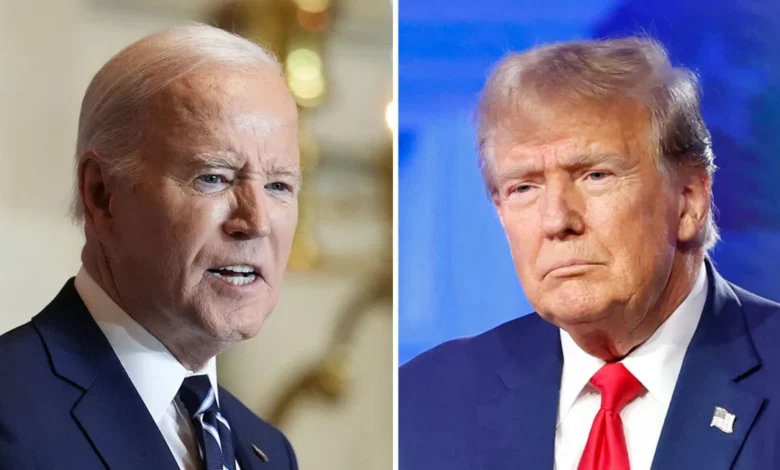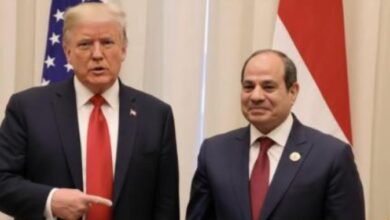
Presidential debates crystalize a quadrennial dilemma for a country contemplating a new political direction. But they’re usually defined more by trivial personality quirks, zeitgeist moments and gaffes than high-level ideological argument.
Al Gore’s melodramatic sighs, George H.W. Bush’s unwise glance at his watch, a day’s growth on Richard Nixon’s chin and Donald Trump’s bulk looming over Hillary Clinton remain iconic years after the policy clashes in those debates have been forgotten.
And while Thursday night’s debate hosted by CNN between President Joe Biden and ex-President Trump could also turn on a theatrical flurry between two men who openly despise one another, the policy meat of a presidential debate has rarely been so important as in this neck-and-neck White House race.
The country is confronting a perilous moment, internally estranged over politics and culture and as multiple foreign policy crises deepen. America faces a choice in November that will lead, like in Robert Frost’s poem, down one of two divergent roads from which there may be no coming back.
A charged political backdrop to a vital debate
Trump’s attempt to regain the White House, less than four years after he attempted to steal the last election, poses a potentially existential question for the democratic system. The former president’s conservative backers are, meanwhile, proposing an evisceration of the bureaucracy and the politicization of judicial and intelligence leadership posts to reconcile the goals of a GOP candidate sporting one criminal conviction, three other indictments and a thirst for revenge.
At the same time, and despite a roaring jobs market, millions of Americans are worn down by high prices and the cost of borrowing. The legacy of a once-in-a-generation pandemic robbed the country of a sense of economic security that Biden promised to restore four years ago but that remains elusive for many. The Supreme Court’s overturning of the constitutional right to an abortion two years ago has opened an ideological and religious schism over reproductive rights that Biden plans to exploit to hurt Trump. But the president is equally vulnerable over an immigration crisis on the southern border that has swamped asylum laws unfit to handle a new generation of migrants fleeing gangs, economic blight and climate disasters.
Overseas, there’s a frightening sense of fracturing. The global system that has enshrined American power for 80 years is under extreme pressure from US foes seeking to destroy it, including Russia and the new superpower China. Biden has dedicated his term to expanding NATO to counter the Kremlin’s onslaught on Ukraine and threat to wider Europe. In one rare area of continuity with Trump, he’s intensified a military and diplomatic pivot to counter China, although the ex-president’s plan for a tariff war with Beijing would go far beyond Biden’s efforts to stop a new Cold War turning hot.
Israel’s war in Gaza, which incessantly threatens to boil over, is a painful vulnerability for a sitting president, as his rival warns that World War III may be about to spark. Trump’s main critique is that Biden is weak – a caricature that could resonate with some voters. But his own plans are as nebulous as his unlikely plan to end the Ukraine war in 24 hours and his unprovable claim that conflicts in Europe and the Middle East would “never have happened” if he’d been in office.
And Trump seems more at home with authoritarians like Russian President Vladimir Putin and North Korean leader Kim Jong Un, who dream of crushing US power, than democratic allies America liberated in the last cataclysmic global conflict. Some of the ex-president’s former White House officials warn he might try to pull the United States out of NATO, the cornerstone of Western security, if he returns to the White House. Voters must therefore pick between Biden’s traditional internationalist foreign policies and a doubling down by Trump of the populist isolationism that turned the United States from the bulwark of global stability into one of its most volatile sources of instability.

Two legacies on display
For the first time in American history, two presidents will stand side-by-side on a debate stage with their legacies exposed for everyone to judge. (The only other time a former and current president competed for a second term was in 1892, when candidates didn’t actively campaign, let alone debate one another.) The meeting of incumbents is one most voters would have preferred to avoid. And so far, their fears seem to be realized. The tied race means two candidates either side of 80 are struggling to show they’ve got the policies to fix the nation’s problems. And neither so far has shown the vision to conjure a road map to the future that millions of Americans will inhabit long after both are gone.
Trump’s first term and sparse legislative record showed that he sees the presidency more as a channel for his wild personal whims rather than a policy laboratory. But his campaign, as well as allied conservative groups, have drawn up plans that, if implemented, would transform American governance. And a second-term administration stripped of restraining influences that frustrated the 45th president means he’d have far more latitude to do what he wants.
One irony of Trump’s first term — and second term proposals — is that while he’s shifted the Republican Party away from its corporate heritage toward a more working-class orientation, he pursues policies that disproportionately help richer Americans like himself. In his first term, he enacted tax cuts that favored the better off and he wants to extend them if he gets back the White House. Still, earlier this month, in an apparent bid to court support from hospitality workers in the key state of Nevada, he pledged to eliminate federal taxes on tips. And while he’s proposing a draconian immigration policy, including mass deportations of undocumented migrants, Trump also says he wants more green cards for foreign graduates of US colleges — a step that may win favor among increasingly influential South Asian voters.
The former president has also signaled he’d dismiss Federal Reserve Chairman Jerome Powell, in a move that would raise concerns of political interference in the central bank but that could please Americans who want interest rate cuts. And the former president is working hard to enhance nostalgia for the Trump economy that was thriving before the pandemic-induced economic crisis.
If he concentrates on economic messaging rather than histrionics on Thursday night, the former president may be able to renew a connection with viewers alienated by his extreme behavior but who pine for easier economic times. Still, Biden is likely to argue that some of Trump’s plans would be economically ruinous, including a proposed 10 percent tariff on foreign goods that some economists warn could reignite the inflation crisis and raise the cost of goods for US consumers.
Biden has a humming policy machine.
Several times a week, the president or Vice President Kamala Harris highlights a new aspect of the administration’s attempt to honor its vows to reshape the economy, to lift up working Americans, to cut health care costs, cap drugs prices, create jobs, fight climate change, preserve abortion rights, reduce student debt and lower energy costs.
But it is the curse of Biden’s term that his efforts rarely get much credit despite a legislative legacy that is as impressive as any Democrat since President Lyndon Johnson. Part of this may lie in the fact that measures like Biden’s bipartisan infrastructure plan may take years to fully come into force.
The president is still yet to figure out a way to claim credit for an economy that rebounded more strongly from the Covid-19 emergency than those of other developed countries while also acknowledging the pain many voters still feel. High grocery prices represent a literal and psychological barrier — even if the worst inflation crisis in 40 years has now moderated. It’s still hard for many Americans to afford a new car or a mortgage because of high interest rates introduced to lower the cost of living. This leaves Biden badly needing to use Thursday night’s debate to convince voters that he can make their lives better — and soon.
He’s tried it once already. During his State of the Union address in March, Biden praised citizens for authoring “the greatest comeback story.” But it didn’t do him any good politically. In an ABC News/Ipsos poll conducted in late April, voters said they trusted Trump more than Biden on the economy and inflation, their top two issues, by margins of 46 percent to 32 percent and 44 percent to 30 percent.
Post-game coverage of Thursday’s debate is certain to zero in on the best verbal jabs, soundbites and the stamina and energy of the rival candidates. But the most meaningful impact of the clash between Trump and Biden will only begin to unfold after noon on Inauguration Day, January 20, 2025.




